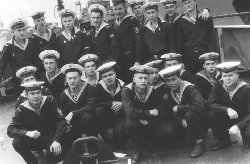 |
Vol 2, No 3
24 January 2000 |
|
|
Staring into the Soul Aleksandr Sokurov's Povinnost' Donato Totaro Povinnost' (Confession, 1998) is a poetic documentary of marine life filmed in five installments of 52 minutes each for Russian television. The director of this existential marine epic is Aleksandr Sokurov, so the term documentary does not begin to describe what the experience of this film is like. Most of the titular "Confession" (perhaps a reference to the ancient philosopher St Augustine and his book Confessions) comes in the form of the ship captain's voice-over monologues. The voice-over throughout, usually the captain's, but sometimes a third person narrater's, is remarkable in its poeticism. For example, in one scene the captain describes the love he holds for his group of young sailors by using the analogy of a beach to a body of water. He is the beach, always there, constant, while the sailors move on and are replaced, like flowing water to his stable land. That such an languorous anti-spectacle was broadcast on television anywhere is mind boggling. I can not imagine a North American viewer returning home from a hard day's work and settling in to watch a mini-series featuring an introspective, soul-searching ship captain and a group of young sailors immersed in daily ship routines (Lars von Trier's The Kingdom maybe, Povinnost', never!). Cinema of oppression Although we learn about the numbing boredom and daily duties associated with an Arctic based naval ship, Sokurov's intentions go beyond such naturalistic detail - though they are present - to a study of human solitude and what happens to the human psyche or soul when placed in oppressive or extended isolation. This is a theme that haunts just about all of Sokurov's work (with the isolation being either physical or emotional). In Mat' i syn (Mother and Son, 1997), a two-player chamber piece, a son and his dying mother spend their remaining moments together at a remote dacha. In Krug vtoroi (The Second Circle, 1990), a darker patriarchal version of Mat' i syn, a son returns home to find his father dead in his apartment. The son, in a perpetual state of stupor, stays with his dead father while town officials enter in and out of the apartment preparing the corpse for burial. In Kamen' (The Stone, 1992), a guard in a museum dedicated to Chekhov remains overnight, talking with what appears to be the ghost of Chekhov. In Sokurov's latest film, Moloch (1999), Adolf Hitler, Eva Maria Braun and other high Nazi officials take refuge in the cliff top, mist-cloaked Berchtesgaden Castle. This thematic seed of isolation and solitude was already planted with Sokurov's first feature diploma film, Odinokii golos cheloveka (The Solitary Voice of Man aka A Man's Lonely Voice, 1978) - as its title gives evidence. The first two episodes of Povinnost' are the most documentary-realist of the five. The naval ship is based out of Murmansk, a northwestern city of the former USSR on the Kola Gulf of the Barents Sea. Murmansk is a leading freight and fishing port and the largest city north of the Arctic Circle. The first two episodes give us a detailed look into the sailor's daily and periodic routines: cooking, eating, folding clothes, bathing, washing their clothes, cleaning the ship, medical examinations and bedtime preparations. Things take a turn for the abstract in the third episode. Most of the third episode takes place outside the ship and consists of panning shots looking through a blizzard, shots of the ship cutting through water, extreme long shots of the bundled-up sailors transporting wood and coal to a barren outpost and a soundtrack that whistles with wind and amplified ambient sounds. Appearing in this third episode is the film's clearest political allusion. Over the image of the bundled-up sailors we hear the captain's voice-over asking "why are they [the sailors] doing this? The tyrant is no longer here." This image, which recalls the Siberia and gulags of Stalinism, is reinforced by several other references or allusions to prison. For example, the sailors are often seen wearing horizontal, striped black and white shirts that look like prison uniforms. In another episode the captain is asked by a visiting captain whether "captains would make good prisoners?" The routine health inspections are reminiscent of prison procedure for new inmates. The sailors wait in a crowded room until they are called in five at a time and then strip searched, front and back. And lastly, there is a shower scene that contains explicit homo-eroticism, a reality of prison life (a sailor sits just inside the shower room ogling, giggling and making eye contact with the other showering sailors). Through all the orders, work and duty, the sailors remain calm, reticent and accepting of everything, with no sign of any protest, least of all strike or mutiny as in Sergei Eisenstein's Bronenosets Potëmkin (Battleship Potemkin, 1925). Politics or philosophy? Is Sokurov being critical of the military for putting these young men through this sterile, dreary existence? It is hard to tell. It seems more like a case of exploiting the claustrophobic setting as an experience for projecting solitude, inner peace and the search for inner self (even if the existential therapy seems reserved to the captain and not the young sailors). The captain, like a Russian version of one of the "book people" from Francois Truffault's/Ray Bradbury's Fahrenheit 451, attempts to memorize Anton Chekhov's work. He says that he must continue to "read thick books written by old men" such as Chekhov, Leo Tolstoy, and Feodor Dostoevsky, writers whom Sokurov also greatly admires. The captain's desire to preserve that part of Russian culture to memory suggests that he may be somewhat of a surrogate for Sokurov, a self-professed Romanticist who claims to not have much interest beyond 19th-century classic Russian literature, or 19th-century culture in general. Like all of Sokurov's films, meaning is diligently represented through a formal rigor that is marked by excessively long (and often static) takes, minimal dialogue and plot, sporadic use of non-diegetic music and somber, painterly cinematography. One of the most striking and difficult to describe aspects of Sokurov's style is its ability to place the viewer in a state of dazed, semi-consciousness; an aesthetically induced trance state.
Shocking the eye into seeing This "stare" is strikingly present in Sokurov's magnificently apocalyptic Dni zatmeniia (Days of the Eclipse,1989), by far his most hypnagogic film. During my first viewing of this film I remember oscillating between semi-sleep states and moments of altered consciousness. At points I nearly dozed off, and at other moments my body tingled from the film's sensual use of form and physical and human landscape. One such scene with an intense "stare" is a sequence where police officers search through a dead man's apartment. The camera is fixed, looking through front and back rooms, with officers milling about in full shot. The sequence lasts for several minutes and is punctuated by very slow dissolves that alter the character configurations slightly. The effect is a time-flux condensation of the film's surreal dreamscape. In Krug vtoroi the "stare" occurs during the scene where a group of men prepare the son's dead father for burial. The scene, over eight minutes long, is composed of three long takes - the middle anchoring shot being just under six minutes - joined by two very slow lap dissolves that account for barely perceptible temporal and spatial ellipses (another common Sokurovian stylistic touch, like the dissolves described above in Dni zatmeniia). The camera is positioned in the kitchen, looking diagonally out through a doorway into a back room where a group of morgue officials busily measure the corpse for a coffin. The son, detached from the exercise, waits in the kitchen. The camera slowly fidgets about the space, eventually craning down to settle behind an old-fashioned wash basin. The son hides up against a wall behind the basin, looking away from the back room. At the end of the shot the workers walk through the door into the kitchen, past the son and out of frame. The door is shut, the scene fades to black. Nothing else happens during the eight minutes plus of screen time. Yet we remain rapt by the camera's ability to sustain our attention between the ordinary basin (foreground), the taciturn son (middle ground), and the busy, but emotionally detached workers (background). In Tikhie stranitsi (Whispering Pages, 1993), the camera looks straight up from the bottom of an abyss-like landing as people, filmed in slow motion, jump over a railing to their apparent deaths. And in Spasi i sokhrani (Save and Protect, 1989), Sokurov achieves the lingering "stare" during the extended finale burial scene of the Flaubertian heroine (as you may have noticed, death is a constant during these protracted "stares"). Meditation and defamiliarization I would like to compare this aesthetically-induced trance-like experience to personal reflections made by Phillip Lopate in his recent collection of essays Totally, Tenderly, Tragically (1998). Lopate refers to such "moving" movie experiences as a form of profane meditation:
Although Lopate does not refer to Sokurov (he mentions directors Robert Bresson and Kenji Mizoguchi), his experience bears a strong similarity to the one I have attempted to describe above. Along more prosaic lines, one can also see this Sokurovian "stare" as an extreme manifestation of the Russian Formalist's theoretical notion of defamiliarization. According to the Russian Formalists, a group of literary theorists from the 1920s (Viktor Shklovskii, Boris Eikhenbaum, Yuri Tynianov, Boris Tomashevskii), the way people look at things, their perception, gets dulled through habitual, everyday living. The basic function of an artwork, then, is to renew this perception, to make people "see" anew. As Viktor Shklovskii writes, "The technique of art is to make objects 'unfamiliar’, to make forms difficult, to increase the difficulty and length of perception because the process of perception is an aesthetic end in itself and must be prolonged. Art is a way of experiencing the artfulness of an object" [2] The intense single-mindedness of Sokurov's "stare", if not aesthetic meditation, is surely an aesthetic of "prolonged and renewed perception" While Povinnost'details the many quotidian duties that are necessary for the ship's outward, physical journey, Sokurov seems more preoccupied with the captain's inner journey, his search for the metaphysical in the real. As he says in voice-over, "We must have faith in something. God, Allah, something." Povinnost'suggests this contrast between the outer/physical and inner/metaphysical with its treatment of interior and exterior spaces. When inside the ship we get mostly clear images, dialogue and routine actions. Realism. Outside the ship images become more abstract, hazier, with far less dialogue, more camera movement, a subtle use of slow motion, moody music and heightened sound effects. Near the end of the film the captain, alone in his cabin, tells us in voice-over that he must continue questioning his soul. The scene cuts to the film's penultimate shot. The camera frames his softly focused hand in front of the lens, as it touches the window glass that separates him from the outside Arctic landscape. This physical gesture underscores the thematic schism between inner and outer states of reality. In the final shot a sailor stands on the deck while a blizzard that rages on covers him in a white sheet. Frozen in thought as well as body, he can only repeat one line: "dear mother." As in most of the episodes, the final shot fades to abstraction. It becomes an indecipherable image that serves Sokurov well as a formal reflection of the philosophical and thematic haze that viewers are often left in after one of his films. Donato Totaro, 24 January 2000 The author is editor of Offscreen
Footnotes 1. Phillip Lopate, Totally, Tenderly, Tragically, 1998, Anchor Books, 1998, pp 78-79.
|
|
![]()
Copyright © 2000 - Central Europe Review and Internet servis, a.s.
All Rights
Reserved

